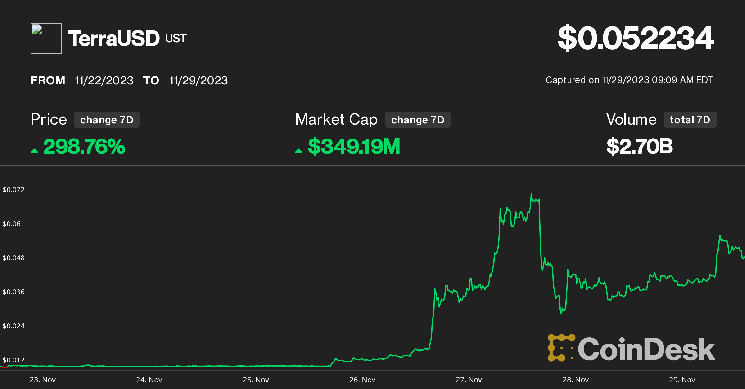TerraClassicUSD (USTC) gained 300% in a week as plans of a bitcoin-backed revamp plan and a Binance perpetual contract listing unleashed a speculative frenzy.
USTC and LUNC underpin the Terra ecosystem, which collapsed last May.
TerraClassicUSD (USTC) and its sister token Terra luna classic (LUNC) – remnants of the blown-up Terra blockchain – skyrocketed this week, fueled by a new Binance perpetuals contract listing and the emergence of a bitcoin-focused revamp and airdrop plan.
LUNC is up roughly 60% this week, including a nearly 20% rise over the past 24 hours, CoinDesk data shows. USTC, meanwhile, has almost quadrupled in price. For perspective, the USTC rally has only brought the price to $0.05 versus its original price peg of $1.
The gains occurred as Binance, which remains the world's largest crypto exchange despite its regulatory issues, on Monday started offering perpetual contracts for USTC with up to 50x leverage.
Increasing anticipation of a USTC revamp plan that would use bitcoin (BTC) as a foundation perhaps also fueled the rally. Bitcoin-focused payment project Mint Cash recently outlined a vision for a successor of Terra's failed stablecoin, this time being collateralized by BTC to mint tokens.
The developer team also revealed a few days ago that they are working on an airdrop plan for USTC and LUNC holders.
The recent developments unleashed a speculative frenzy around the token. Trading volume with USTC has exploded in the last few days, peaking at times above $1 billion in 24-hour activity, dwarfing the less than $10 million average earlier this month, CoinGecko data shows.
Remnants of Terra
Terra luna classic (LUNC) and USTC are remnants of the sister tokens that underpinned the once-huge, failed Terra ecosystem, developed by Terraform Labs and helmed by co-founder Do Kwon, who was arrested earlier this year. USTC was an algorithmic stablecoin, while LUNC – then named LUNA – was used to balance the stablecoin at a $1 peg. The design proved to be unsustainable and the tokens fell into a hyperinflationary death spiral last May, collapsing the whole multibillion-dollar Terra ecosystem in spectacular fashion.
Read more: A Timeline of the Meteoric Rise and Crash of UST and LUNA
The U.S. Securities and Exchange Commission (SEC) this February charged Terraform Labs and Kwon with "orchestrating a multi-billion dollar crypto asset securities fraud involving an algorithmic stablecoin." Kwon was arrested in Montenegro with forged passports in March and last week a local court approved extraditing him to the U.S. or South Korea.
Soon after the collapse, developers deployed a new version of the Terra blockchain with a brand new native token called LUNA, consequently renaming the old blockchain to Terra Classic and the tokens to LUNC and USTC.
Some developers, however, remained committed to revive the ecosystem around Terra Classic. The community voted to stop minting – creating – new USTC tokens to help reduce its hyperinflated supply through token burning schemes.
 coindesk.com
coindesk.com
